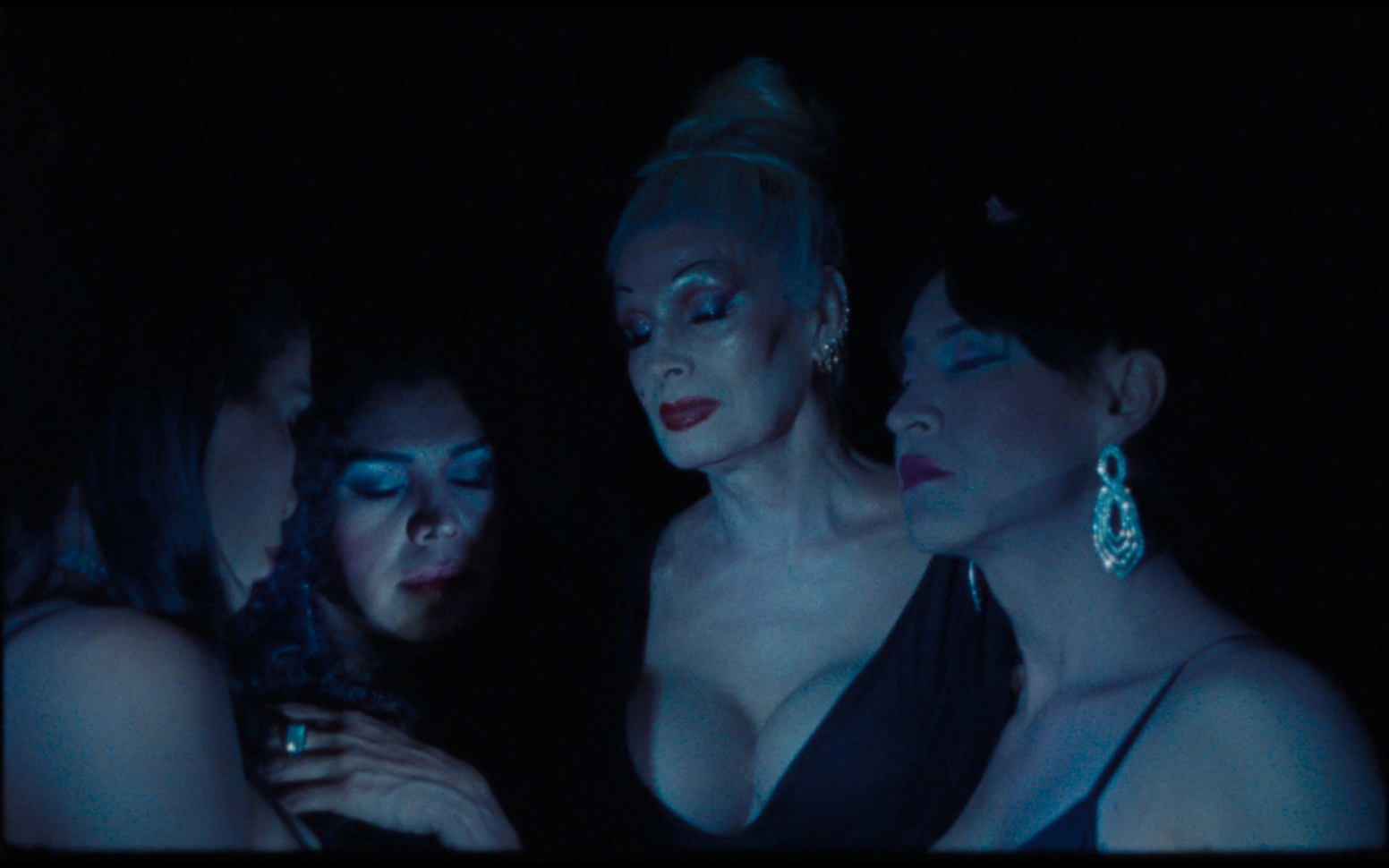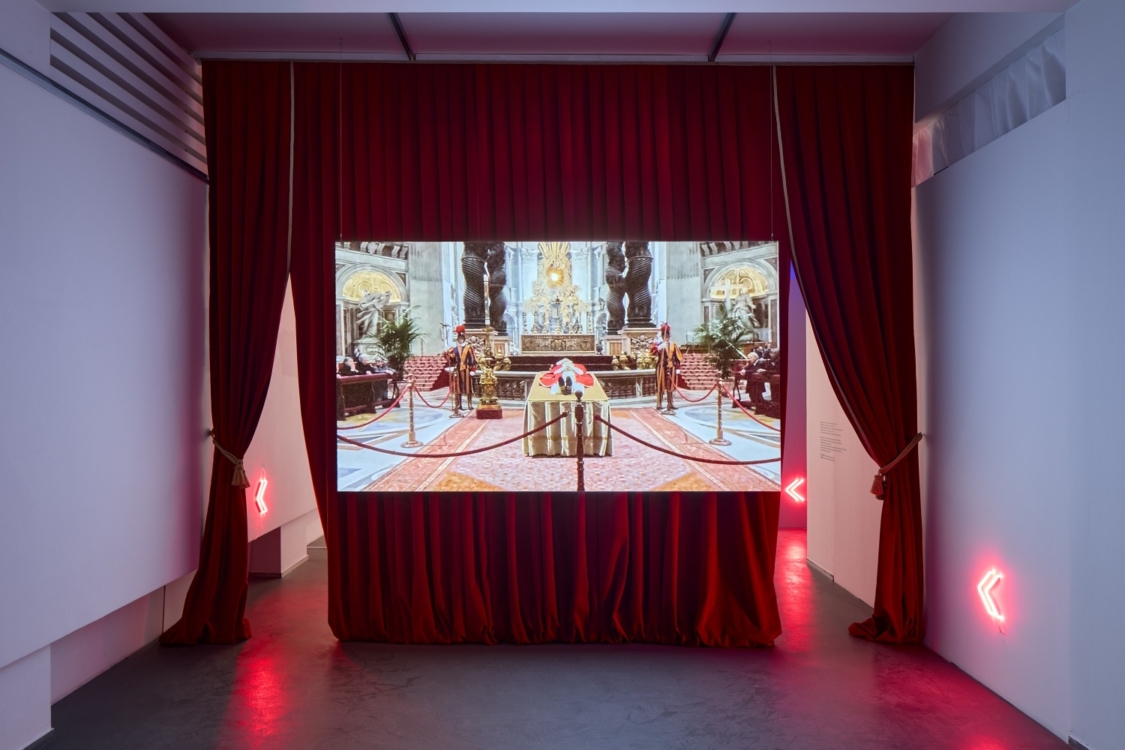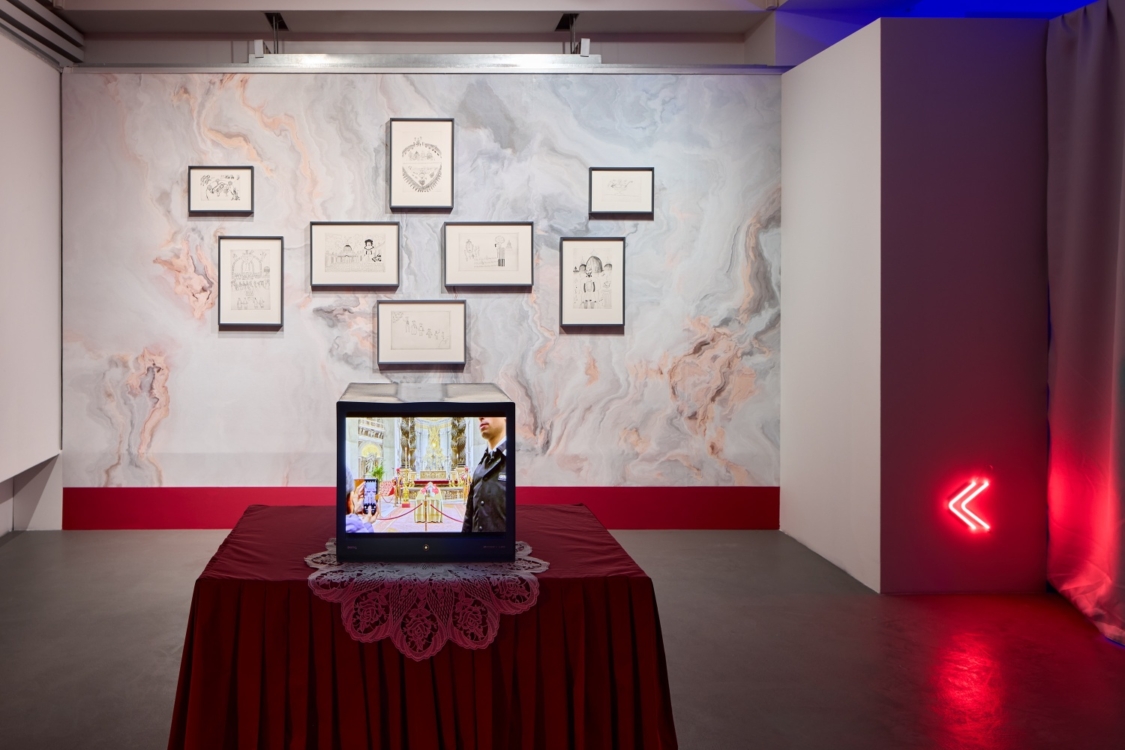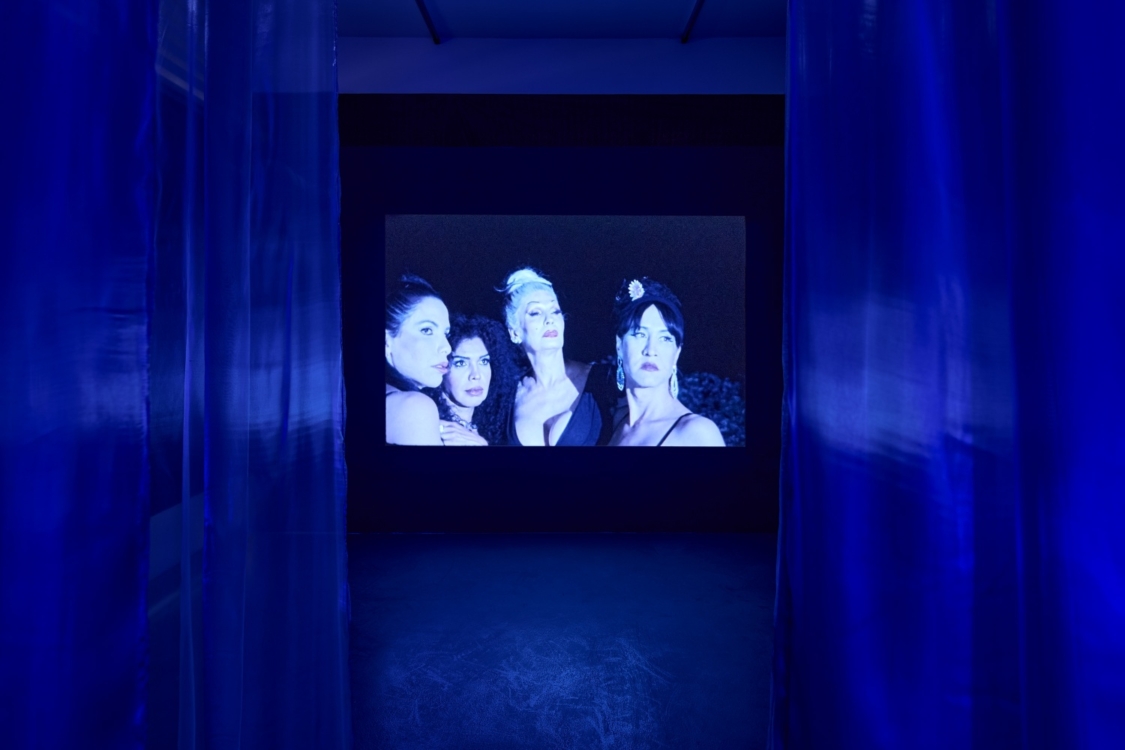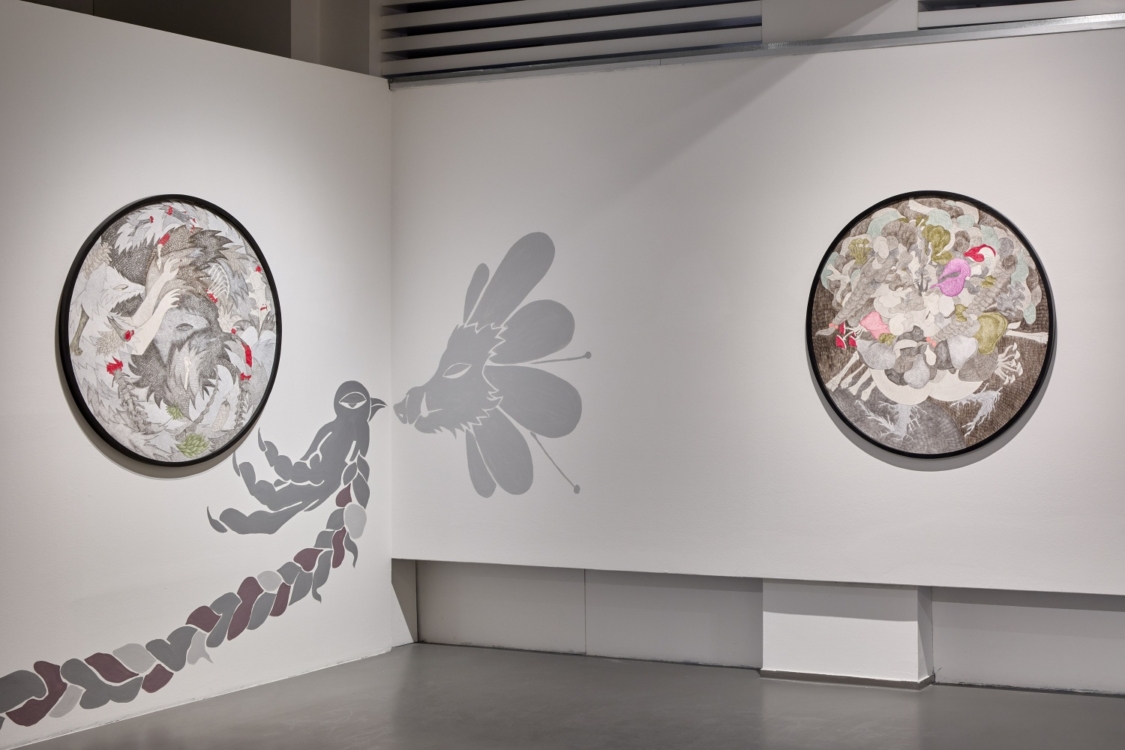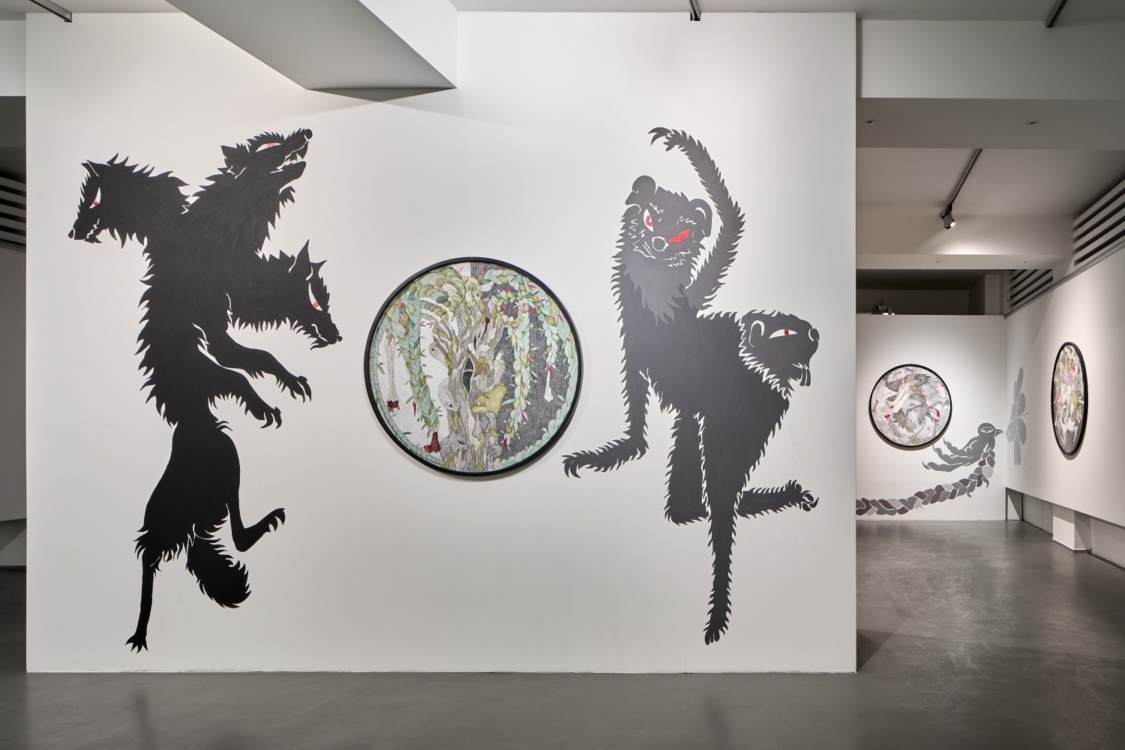Divas / Roman Parties Marie Lukáčová / Pauline Curnier Jardin a Feel Good Cooperative 14. 11. 2023 – 25. 2. 2024
Curator: Jitka Hlaváčková and the curatorial collective of the Jindřich Chalupecký Society: Barbora Ciprová, Veronika Čechová, Tereza Jindrová, Karina Kottová
A collective of curators from Prague City Gallery and the Jindřich Chalupecký Society will present current works by internationally established artists in the field of the moving image and multimedia installations. At both exhibitions, the exhibiting artists address socially engaged themes of gender and politics in their documentary and narrative-based works. They reveal the social experience and perspective of very young or socially excluded women marginalised in terms of power in a patriarchal society. The two exhibitions are the result of a broad team collaborating at the authorial, curatorial, and institutional level.
Exhibiting artists: Marie Lukáčová and Pauline Curnier Jardin
Pauline Curnier Jardin & Feel Good Cooperative: Roman Parties
The Rome Parties exhibition presents the results of a unique collaboration between an internationally established artist, Pauline Curnier Jardin, and a collective of female sex workers, artists, and architects who, since 2020, have been performing under the collective name Feel Good Cooperative. Curnier Jardin, who lives and works part time in Rome, co-initiated the formation of the creative group, which is mostly made up of Colombian-born sex workers, during the global pandemic when a strict lockdown was imposed in Italy. Sex workers who depended on being able to meet their clients in person were among those at real risk of getting into material need. Pauline Curnier Jardin, with the help of photographer and sex worker Alexandra Lopez and architect Serena Olcuire, devised a workshop for a group of female sex workers which resulted in a series of drawings depicting scenes from their everyday work interactions. These were sold for a price equivalent to the fees for their regular work. This initiatory project thus created a new space for self-expression for those whose daily lives are stigmatised and ignored by mainstream society.
The exhibition at the House of Photography features three films and related drawings, and for each section a spatial and installation environment is created that resonates with the theme and atmosphere of the particular work.
The first video is a recording of a performance on 12 October 2023, when Christopher Columbus Day is celebrated in Italy and other countries around the world. The iconic position of this famous navigator and historically celebrated discoverer of the “New World” has been increasingly shaken in recent years by critical reflection on the epoch of European colonialism. The performance by members of the Feel Good Cooperative was intended to subvert the traditional motive for Columbus Day celebrations through physical movement, sculptural intervention, and collective singing, a polyphony of yearning bodies, so as to change the meaning of sites in the public space that symbolise exploitation and power.
The second film in the exhibition is also documentary in nature. It depicts a January 2023 trip to the Vatican when members of the Feel Good Cooperative — as well as a total of 195,000 Christians from around the world — went to bid farewell to the late Pope Emeritus Benedict XVI during the funeral display of his body in St. Peter’s Basilica. The half-hour film The Day We Saw Him Dead follows members of the collective in their everyday clothes and make-up walking through the breathtaking interiors of one of Catholicism’s holiest sites.
After watching the film, viewers are allowed to enter an imaginary sacristy, but instead of the devotional objects and vestments, there is an installation of prints from the Death of the Pope series – the result of another creative workshop in collaboration between Curnier Jardin and the Feel Good Cooperative. In a uniquely apt, humorous, and narrative way, the drawings capture scenes and impressions from the visit to the Vatican, blending the worlds of religiosity, mass tourism, female sexuality, and carnality.
The last part of the exhibition features a 2021film, the first ever produced by Pauline Curnier Jardin and the Feel Good Cooperative. The mysterious video, entitled Fireflies, features the now familiar figures at night, in a flicker of shadows and lights along the roadside on the outskirts of Rome where they usually work. Once upon a time, there were indeed fireflies here, but they have disappeared along with the changing suburban landscape around them. Today the car headlights of potential clients in search of a one-off pleasure illuminate like searchlights faces and bodies – the faces and bodies we already know from the previous two film encounters. A metaphor in which the fireflies are the women and trans people who appear at night but are invisible during the day, lacking social recognition and support. But the Feel Good Cooperative’s artworks and projects show them in an emancipatory light, as strong, beautiful, and remarkable.
Marie Lukáčová: Divas
The exhibition Divas is part of a multimedia trilogy aimed — rather unusually in contemporary art – primarily at teenagers. Its other parts are the film Orla (Female Eagle) and the author’s book The Dragon and the Fish. Each of the parts take place on a different time plane. The Orla film whose first part is also included in the exhibition, corresponds to that part of the book’s plotline between the prologue and its main plot. The timeline of the exhibition, consisting of an elaborate series of drawings, prints, and murals, unfolds in a process of artistic transformations, unrestricted in terms of time, where a new world of myths and symbols is formed by the embodiment of different truths.
In the subjective perspectives of Marie Lukáčová’s protagonists, the focus of the myth shifts towards corporeality and sensory experience, while classical patterns, balancing on the fluid interface of innocence and sexuality, are maintained. In the sometimes naive fairy tale stories but also in, on the contrary, very sophisticated fantastic illustrations and animations, the principal motive is a radical re-embracing of the physical – and therefore sexual – aspects of life in the cultural canon, that represents a return to the original even though newly formulated folk wisdom.
As a certain form of religious text, the myth also satisfies the natural, currently under-satisfied need for the complexity: The Dragon and the Fish story also contains the paradigm of origination, extinction and overcoming extinction. And as in this story, most folk rituals throughout history have been sustained by feminine energy – with an emphasis on the intimacy of both community and female reciprocity, on physicality in folk rituals, and on emotions associated with motherhood, sexuality, menstruation, childbirth, adolescence, as well as violence and death. And above all on their unconditional connection with nature. Marie Lukáčová’s drawings and animations, in their decorative nature, refer to the phenomenon of traditional works, which have their own specific temporality: for example, the making of bobbin lace in some ways resembles the spinning of mythical forms into individual stories. Both contain creative approaches and rhythms of repetition that adopt the principles of natural cycles and processes.
Marie Lukáčová shows that the way to preserve the continuity of life is not to break down traditions, but to appropriate them. To add to them additional, current layers of meaning through new stories. To create new rituals that revive deeply rooted mythological themes that have the ability to release hidden energy. All of this takes on new meaning at a time when society is facing challenges and threats arising from apparently unsustainable social paradigms.
Pauline Curnier Jardin (born in 1980 in Marseille) is a visual artist, filmmaker and performer who draws from a vast repertoire of references, ranging from Graeco-Roman mythology to folk tales, from various religious practices to pagan rituals. Her films and installations, which she often conceives as theatrical stages, reflect spaces of play or popular entertainment, such as circuses, cabarets, carnivals or fun fairs, worlds where all identities, every kind of cross-dressing and reversal, is allowed. In a kind of wild and organic ethnology, Pauline Curnier Jardin documents various rituals: processions, pilgrimages, votive festivals. She has showcased her works in prestigious international museums and institutions. Curnier Jardin received numerous accolades, including the Prize der Nationalgalerie in 2019, the Villa Medici Residency 2019/2020 in Rome, and the Villa Romana Fellows 2021 in Florence. Other prestigious awards include the Dutch NN Award (2018) and the Prix Fondation d’Entreprise Ricard (2017).
Feel Good Cooperative is a collective comprising Colombian trans sex workers and their allies. This collective emerged in Rome during the Spring 2020 lockdown, driven by the artist Pauline Curnier Jardin, photographer and sex worker Alexandra Lopez, and architect and researcher Serena Olcuire. Recognizing art as a powerful space for expression and economic empowerment, Feel Good Cooperative aims to uplift subjectivities that have historically faced marginalization, stigma, and exclusion from self-representation. Through collective works and performances, they create art from shared experiences and training workshops that encompass diverse artistic techniques. The reach of Feel Good Cooperative’s works extends to various cities, including Rome, Berlin, Genoa, Bonn, Cologne and now Prague.
Marie Lukáčová (1991, Opava) has long been an established artist in the field of visual art and music. She graduated from the Brno-based University of Technology and UMPRUM (Academy of Arts, Architecture and Design) in Prague, has served as a lecturer at CAS FAMU, and is one of the few Czech artists who, in addition to her role as an artist, is also involved in the demanding field of film production. She presents her stories in multimedia installations combining feature film and animated film, music (especially rap), drawings, prints and murals. She includes in her stories, founded on documentary as well as narrative principles, socially engaged motifs from the fields of gender and politics, as well as from folk religion and science which plays the role of modern mythology. Primarily from a feminine perspective, she highlights the self-destructive role of a polarised, patriarchal society in the current era of global environmental and social crises.

